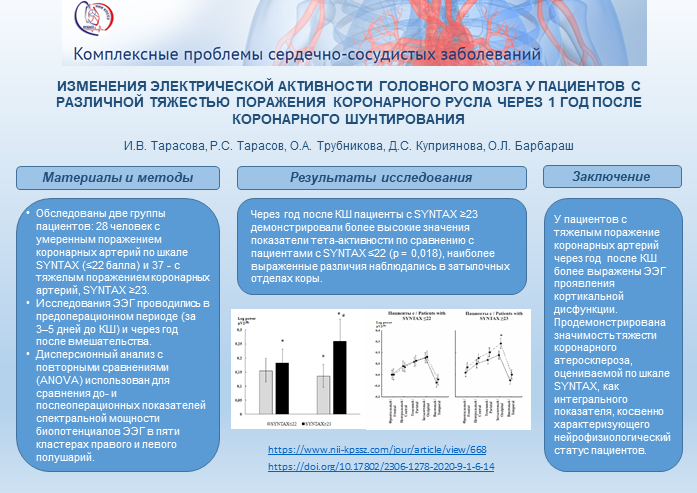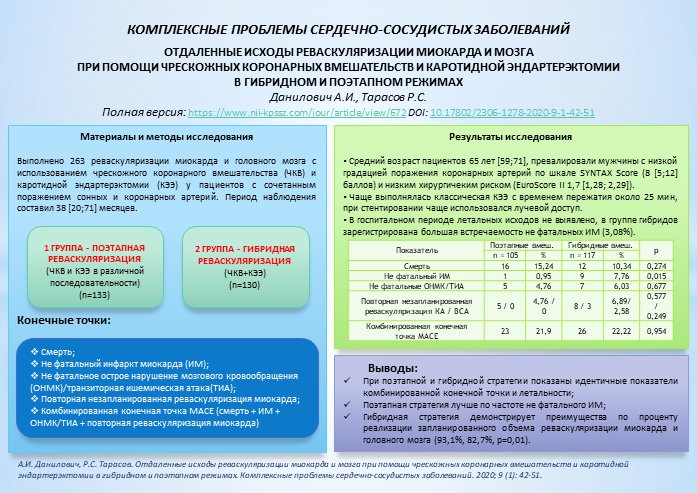ORIGINAL STUDIES. Cardiology
Aim.To examine the brain electrical activity changes with the quantitative electroencephalogram (qEEG) indicators (the spectral power) in patients at 1 year after on-pump coronary artery bypass grafting (CABG) depending on the severity of the coronary lesions.
Methods.65 patients were included in the study. Before performing CABG, they were divided into two groups depending on the severity of coronary artery disease according to the SYNTAX score: patients with mild coronary artery lesions – SYNTAX ≤22, (n = 28) and patients with severe coronary lesions – SYNTAX ≥ 23, (n = 37). EEG studies were performed in the preoperative period (at days 3–5 before GABG) and 1 year after surgery. Variance analysis with repeated comparisons (ANOVA) was used to compare pre-and postoperative EEG spectral power indicators in five clusters of the right and left hemispheres.
Results.Patients with SYNTAX ≥23 had higher theta rhythm power values as compared with patients with SYNTAX ≤22 (p = 0.018) at 1 year after CABG, whereas these groups were comparable before the surgery. In addition, patients with severe lesions of the coronary arteries (SYNTAX ≥23) demonstrated an increase of theta rhythm power at 1 year after surgery in comparison to preoperative values (p = 0.017), this effect was not detected in patients with SYNTAX ≤22.
Conclusion.One year after CABG, patients with severe coronary lesions (SYNTAX ≥23), demonstrated qEEG changes that resembled cortical dysfunction, showing significance of severity of coronary atherosclerosis, assessed by the SYNTAX score, as an integral indicator, indirectly characterizing neurophysiological status of patients.Aim. To examine the differences in clinical parameters in patients with coronary atherosclerosis based on fatty acid profile.
Methods.60 men with angiographically verified atherosclerosis of the coronary arteries underwent the analysis of fatty acids followed by coronary endarterectomy. Patients were divided into two groups after histological analysis of the intimamedia fragments. Men without unstable plaques in the coronary arteries were included in Group 1, whereas patients with unstable atherosclerotic plaques were included in Group 2. Blood serum levels of fatty acids were measured by highefficiency gas-liquid chromatography.
Results.The predicted probability value and the predicted group membership in men with coronary atherosclerosis were calculated using the logistic regression. The following clinical patterns in men with unstable atherosclerotic plaques included increased prevalence of myocardial infarction with the event over 10 years ago, severe angina pectoris (III and IV functional class) and chronic heart failure, in comparison with CAD patients without unstable plaques.
Conclusion. Fatty acid profile was associated with altered individual history of coronary atherosclerosis.
ORIGINAL STUDIES. Cardiovascular surgery
Aim.To determine gender differences in immediate outcomes of patients with acute non-ST-elevation myocardial infarction undergoing off-pump coronary artery bypass grafting (CABG).
Methods.CABG was indicated to patients with persistent myocardial ischemia (postinfarction angina) who did not meet criteria for percutaneous coronary intervention. Hybrid procedures and CABG aimed at repairing mechanical complications of AMI were not considered. Men (n = 66, 65.3%) were assigned to Group 1, whereas women (n = 35, 34.7%) were assigned to Group 2. Women were older and obese (grades 2-3), had higher GRACE scores, levels of cardiospecific troponin and higher rate of type 2 diabetes (p<0.05). Men and women commonly had three-vessel CAD (3.0; 4.0). The mean SYNTAX score for men and women was 29.0 (24.0; 33.0) and 27.0 (24.0; 28.0), p>0.05.
Results.The median preoperative period was 4.0 days (3.8; 5.0) in male patients and 5.0 (4.0; 6.0) days in female patients (p>0.05). The groups did not have any significant differences in technical aspects of CABG (p>0.05). Mortality was 3.0% in men and 2.9% in women (p>0.05). No deaths were recorded from the onset of AMI till the first 72 hours after CABG. Three patients who under CABG died after 72 hours from the onset of MI (p>0.05). The total number of complications was 13 (19.7%) in men and 5 (14.3%) in women (p>0.05). There were no cases of conversion to cardiopulmonary bypass.
Conclusion.The immediate outcomes of delayed of-pump CABG in both, men and women with acute non-ST-segment myocardial infarction, were comparable in mortality and complications (p>0.05). The immediate outcomes of CABG performed within 72 hours in both, men and women, were comparable in mortality as compared to surgeries performed after 72 hours from the MI onset. Obtained data demonstrated safety of early open-heart surgeries for acute non-ST-elevation myocardial infarction.
Aim.To compare hemodynamics between four different aortic tissue valves implanted in the elder patients. The stented bioprostheses sizes were 21, 23, and 25. All bioprostheses were produced by different manufacturers.
Methods.135 patients who underwent aortic valve replacement at the Belgorod Regional Clinical Hospital in the period from January 01, 2007 to June 01, 2018 were included in the retrospective non-randomized clinical study. Implantation of 21 mm tissue heart valves was performed in 50 patients, 23 mm - in 66 patients, and 25 mm - in 29 patients. Stented bioprostheses Carpentier-Edwards PERIMOUNT (Edwards, USA), Aspire (Vascutek, USA), Hancock-2 (Medtroniс, USA), and UniLine (NeoCor, Russia) were used in the study.
Results.Valve function was estimated by transthoracic echocardiography at days 10-14 postoperatively. Peak gradient, left ventricular stroke volume, the ratio between stroke volume and maximum gradient (SV/∆р mах), the ratio between SV/∆р mах and BSA were measured in all patients. The stented UniLine tissue heart valve (NeoCor) demonstrated superior hydrodynamic parameters, whereas stented Hancock-2 tissue heart valve had inferior ones.
Conclusion.Patients who underwent aortic valve replacement with UniLine (NeoCor) reported low peak gradient, improved stroke volume and better peripheral perfusion in the immediate postoperative period. Obtained data suggest that UniLine is more durable and results in better systolic and diastolic left ventricle function, leading to left ventricle hypertrophy regression.
Aim To evaluate in-hospital and long-term outcomes of myocardial and cerebral revascularization with combined or staged PCI and carotid endarterectomy.
Methods.263 myocardial and cerebral revascularizations with PCI and CEA in patients with combined cerebral and coronary artery lesions in the period from 2011 to 2017 were performed. Patients were divided into two groups depending on the surgical strategy. Patient (n = 133) who underwent a staged intervention (CEA and PCI) were included in Group 1, whereas patients (n = 130) who underwent a hybrid intervention (CEE+PCI CA) were included in Group 2. The mean follow-up was 3.5 years.
Results.100% of patients in Group 2 underwent coronary and internal carotid revascularization according to the results of in-hospital and long-term follow-up. 81.35% of patient in Group 1 underwent PCI and CEA, whereas 3.01% of patients underwent only PCI and 6.77% of patients – CEA. 1.5% of patients in Group 1 did not receive any surgical treatment. The most common causes of incomplete revascularization were the subsequent change of the initially defined treatment for myocardial (6.02%) or cerebral revascularization (0.75%). The rest refused the second stage, or it was associated with extremely high risk and the strategy was switched to the conservative therapy.
Conclusion.100% of patients received hybrid myocardial and cerebral revascularization during one hospitalization. It allowed reducing mortality from MI and stroke during the waiting period for the next stage of the treatment in Group 1 (almost 5%). Hybrid interventions can be used in patients with high risk for open-heart surgery, severe comorbidities (obesity, diabetes, renal dysfunction), significant coronary and cerebral artery lesions with high risk of MI and stroke. However, hybrid approach was associated with high rate (almost 7%) of non-fatal MI in the long-term follow-up.
ORIGINAL STUDIES. Pathological physiology
Background.The availability of drug-eluting stents with evidence-based clinical safety and efficacy produced in the Russian Federation is one of the relevant goals for successful treating of patients with coronary artery disease, including acute coronary syndrome. Aim To confirm clinical rationale and experimental feasibility of the first Russian drugeluting stent, Calypso (Angioline, LLC, Russian Federation), for the clinical practice.
Methods.The study included four phases. The first phase was aimed at selecting the optimal stent platform with superior healing properties. Then, the selected Russian coronary stents based on the optimal platforms underwent preclinical studies. The third phase included the clinical assessment using optical coherence tomography (OCT) in order to confirm the preclinical results. The last phase was focused on assessing clinical safety and efficacy of the Russian coronary stent based on the comparative analysis of angiographic findings within the 12-months follow-up.
Results.At the first phase, biodegradable polymer sirolimus-eluting stent showed superior healing properties in comparison with the healing score of 18±14.97 for Orsiro stents (Biotronik, Germany) versus 25.6±1.0 for Xience stents (Abbott Vascular, USA) versus 32.5±20.3 for Synergy (Boston Scientific, USA), p<0.001. The Russian stent consistently demonstrated a high healing profile in preclinical and OCT clinical studies. The results of the comparative clinical study proved the clinical safety and efficacy of the Russian stent that was similar to the best foreign stents. None of the differences in the incidence of binary restenosis were found between the groups (p<0.05).
Conclusion.The biodegradable polymer sirolimus-eluting stent Calypso manufactured in the Russian Federation demonstrated superior neointimal healing pattern with no signs of chronic inflammation in the experiment. This stent reported high neointimal healing properties according to the clinical OCT study. According to the angiographic findings, the incidence of binary restenosis between the Russian biodegradable polymer sirolimus-eluting stent and durable polymer everolimuseluting stents was similar at the 12-months follow-up (p>0.05).
Aim.To evaluate the effects of long-term wet treatment of porcine aortic wall fragments with biocidal solutions (glutaraldehyde, antibiotics, alcohol-glycerin mixture, complex alcohol solution (CAS)) on the severity of degradation of samples’ connective matrix and their long-term ability to accumulate calcium during subcutaneous implantation in laboratory rats (1 and 3 months).
Methods.Histological analysis of freshly collected material was performed after 50 days of treatment with various biocidal solutions and after subcutaneous implantation of samples in small laboratory animals at 1 and 3 months. Calcium was measured with the atomic absorption spectroscopy after 3 months of subcutaneous implantation.
Results.Histological analysis reported that connective matrix of samples treated with glutaraldehyde, antibiotics, and CAS was similar to the native one (with the exception of partial loss of cellular components in samples). After 1 month of implantation, a moderate degradation of connective tissue was found. The treatment with the alcohol-glycerin mixture was associated with the most severe degradation. After 3 months of implantation, glutaraldehyde-treated samples had the most preserved connective matrix, while alcohol-glycerin-treated samples demonstrated severe connective matrix injury. However, severe calcific deposits were found in samples treated with glutaraldehyde, whereas mild ones were detected in samples treated with alcohol-glycerin. Atomic absorption spectroscopy reported that calcific deposits in Cas- and alcohol-glycerin-treated samples were 2.3 and 1.8 times lower than those in glutaraldehyde-treated samples. The calcium content in samples treated with antibiotics did not differ significantly from those in glutaraldehyde-treated samples
Conclusion.The comprehensive analysis of the effects of various treatment media on the stability of connective matrix to subsequent degradation and its ability to accumulate calcium found that CAS was the most preferred medium for long-term wet treatment of xenoprosthetic vascular tissue.
REVIEWS. Cardiovascular surgery
REVIEWS. Pathological physiology
CASE STUDY
ISSN 2587-9537 (Online)









































